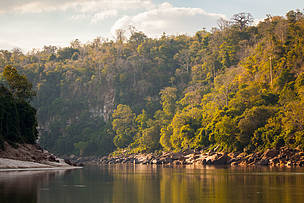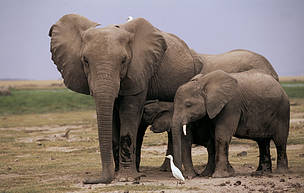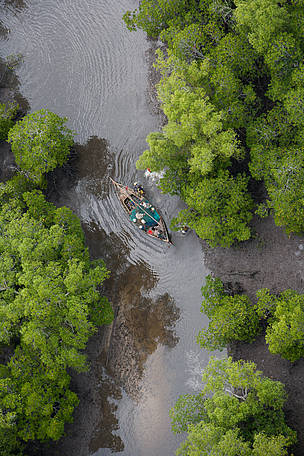Tanzania announces key assessment for Selous World Heritage site
In a welcome move, Tanzania has announced the launch of a vital Strategic Environmental Assessment (SEA) of the proposed Stiegler’s Gorge hydropower plant in the Selous World Heritage site at a World Heritage Committee meeting in Bahrain on June 27.

Stiegler’s Gorge on the Rufiji River in Selous Game Reserve, Tanzania.
Plans to generate 2,100 MW of power from the Stiegler’s Gorge hydropower dam have been pushed forward by Tanzania’s government despite concerns over its environmental and social impacts. Crucially, the SEA is required under Tanzanian law, as stipulated in the Environmental Management Act 2004. This will help inform strategic decisions the government can take on Selous’ development.

An elephant and a calf in the Selous Game Reserve
Commenting on the announcement, Anthony Field, Global Campaign Manager at WWF International, said on June 27:
“WWF welcomes the Tanzanian government’s commitment today to initiate the required Strategic Environmental Assessment. The move represents important progress but it is crucial that the assessment is completed without delay to the highest international standards and is independently reviewed. It must also examine alternative, less harmful energy projects that could instead be pursued and cover the ecoregion in its entirety to secure the future of this wilderness site for generations to come.”

Arial view on river with small boat - Selous
The Tanzanian government’s decision to initiate the SEA comes as the World Heritage Committee adds the Stiegler’s Gorge project as a factor that puts the Selous on UNESCO’s list of World Heritage in Danger in recognition of the serious and irreversible impacts it could have.
“The decision by the World Heritage Committee to add the Stiegler’s Gorge hydropower project to the Selous Game reserve’s In Danger listing reflects the proposed dam’s direct threat to the Selous’ globally important wildlife populations and the risks to the livelihoods of more than 200,000 people that live downstream,” added Field. “It is critical that no work starts on the project before the SEA has been completed, reviewed and agreed with the World Heritage Centre.”
A World Heritage site since 1982, the Selous Game Reserve is one of Africa’s largest remaining wilderness areas and home to globally significant populations of elephants, black rhinos and wild hunting dogs.
At the meeting, the World Heritage Committee recognized the anti-poaching progress that has been made in Selous, which has potentially stabilized the elephant population and shown that black rhinos are still present in the reserve. However, the committee agreed that this progress has been overshadowed by the proposal to build the Stiegler’s Gorge dam inside the World Heritage site.
In January 2018, Audrey Azoulay, the Director-General of UNESCO, wrote a letter expressing her concern about the irreversible damage the project could have on the Selous. In their reactive monitoring mission report in 2017, the International Union for Conservation of Nature (IUCN) said that the project is ‘fatally flawed’ because of its ecological impact. It called on the government of Tanzania to ‘permanently abandon’ it.
A WWF commissioned analysis, published in July 2017, found that the proposed dam threatens both the Selous Game Reserve World Heritage site and the adjacent Rufiji-Mafia-Kilwa Marine Ramsar site.
Source: World Wildlife Fund
- 251 reads
Human Rights
Ringing FOWPAL’s Peace Bell for the World:Nobel Peace Prize Laureates’ Visions and Actions

Protecting the World’s Cultural Diversity for a Sustainable Future

The Peace Bell Resonates at the 27th Eurasian Economic Summit

Declaration of World Day of the Power of Hope Endorsed by People in 158 Nations

Puppet Show I International Friendship Day 2020

